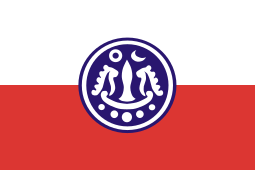Kaladan River
The Kaladan River (Burmese: ကုလားတန်မြစ်, pronounced [kəládàɰ̃ mjɪʔ]; also Kysapnadi, Beino, Bawinu and Kolodyne) is a river in eastern Mizoram State of India, and in Chin State and Rakhine State of western Myanmar.[1] The Kaladan River is called the Chhimtuipui River in India.[2] It forms the international border between India and Burma between 22° 47′ 10" N (where its tributary, the Tio River, joins it) and 22° 11′ 06" N.[1]
| Kaladan Kysapnadi, Beino, Bawinu, Bawinung(Boinung) | |
|---|---|
 Kaladan river | |
| Native name | ကုလားတန်မြစ် |
| Location | |
| Country | Myanmar, India |
| State | Chin State, Rakhine State, Mizoram |
| Physical characteristics | |
| Source | west flank of Mount Zinghmuh |
| • location | Chin Hills, Chin State, Myanmar |
| • coordinates | 22°49′28″N 93°31′57″E |
| • elevation | 2,564 m (8,412 ft) |
| Mouth | Sittwe |
• location | Bay of Bengal, Myanmar |
• coordinates | 20°06′00″N 92°54′09″E |
• elevation | 0 m (0 ft) |
| Discharge | |
| • average | 3,468 m3/s (122,500 cu ft/s) |
| Basin features | |
| Tributaries | |
| • left | Twe River, Mi River, Kalabon River, Kyegu River |
| • right | Chal River, Tio River, Tuichang, Mat River, Kawrthingdeng River |
History
Kaladan was an entry point to Mizoram from the seaport of Sittwe in 1904. Kaladan is Mizoram's largest river and it flows through its southeastern region.[3]
Geography
The river arises in central Chin State as the Timit, 22° 49′ 28″ N 93° 31′ 57" E, and flows south and is soon joined by the Chal, after which it is known as the Boinu River. It continues south until just before it is joined by the Twe River at 22° 08′ 40″ N 93° 34′ 30″ E, when it swings west. It continues west until 22° 05′ 20″ N 93° 14′ 12″ E, when it heads northwest. At 22° 11′ 06″ N 93° 09′ 29″ E, below Mount Phabipa, it turns north and becomes the international border between India and Myanmar. It flows north to 22° 47′ 09″ N 93° 05′ 47″ E, where the international border continues north along the Tyao River, and the Boinu heads northwest into Mizoram State, at which point it is known as the Kaladan.
At 22° 56′ 21″ N 92° 58′ 55″ E it reaches its northernmost point, and turns south west, is joined by the Tuichong River from the right and then heads south.[4] The Kaladan is joined from the right by the Mat River at 22° 43′ 39″ N, 92° 54′ 46″ E. It continues south and is joined by the Kawrthingdeng River from the right. It again enters Chin State, at Raithaw Ferry, 22° 03′ 40″ N 92° 51′ 05″ E,[4] just northwest of Khenkhar. The Mi River joins from the left at 21° 06′ 56″ N 92° 57′ 42″ E.[5] At Ngame the river enters the Rakhine State of Myanmar and continues south to Sittwe where it enters the Bay of Bengal.
Development
At present, the Kaladan is the fifth largest river in the world to remain completely unfragmented by dams anywhere in its catchment, behind only the Fly, Mamberamo and Sepik in New Guinea and the Pechora in Russia.[6] Nonetheless, the governments of India and Myanmar are working on a US$500 million, Kaladan Multi-Modal Transit Transport Project that will facilitate trade between the two nations.[7] The project includes the construction of the US$120 million deepwater Sittwe Port at the mouth of the river, dredging of the Kaladan River to enable cargo vessels to navigate the river from Sittwe to Mizoram, the construction of a river port at Paletwa, as well as the widening and upgrade of highways between Paletwa and Myeikwa on the Indo-Myanmar border.[8] India undertook the development of the 158 km river boat route from Sittwe seaport to the Inland Water Terminal (IWT) and hydropower project at Paletwa jetty via the Kaladan River in Myanmar.[9][10] River dredging and a jetty upgrade were completed in June 2017.[9][10] There is at least one river lock for navigation.[11] The project will open up not only Mizoram but all of India's northeastern states as hinterland for the Sittwe Port. Construction for the port started in 2010 and is expected to be completed by mid-2020.
Development of the river is also being negotiated with the Shwe Gas Project for economic enhancement [12]
See also
- Kaladan Multi-Modal Transit Transport Project
- East-West Industrial Corridor Highway, Arunachal Pradesh
- Arunachal Border Highway
- Asian Highway Network
- India-Myanmar-Thailand Friendship Highway
References
- NF 46-7 "Gangaw, Burma" U.S. Army Map Service topographic map 1:250,000, 1954, first printing April 1958
- [https://www.thestatesman.com/supplements/north/still-under-construction-1502635461.html Still under construction[, The Statesman.
- Pachuau, Joy. The Camera as a Witness. Cambridge University Press. p. 153. ISBN 9781107073395.
- NF 46-6 "Chittagong, Pakistan" U.S. Army Map Service topographic map 1:250,000, 1955, first printing March 1960
- "Cox's Bazar, Pakistan" U.S. Army Map Service topographic map 1:250,000, 1954, first printing March 1960
- "Fragmentation and Flow Regulation of the World's Large River Systems" (PDF). Archived from the original (PDF) on 30 March 2012. Retrieved 12 January 2013.
- The Hindu Business Line : `Work on Kaladan river project in Mizo to start soon'
- "Construction of Sittwe Port for Kaladan Multiple River Project Starts". Indo-Burma News. 1 December 2010. Archived from the original on 1 April 2012. Retrieved 14 October 2011.
- India awards road contract to complete Kaladan project in Myanmar, Business Line, 9 June 2017.
- India ramps up Myanmar ties
- India's connectivity to Myanmar.
- The Shwe Project — Shwe Gas Movement [For a Sustainable Future in a Free and Democratic Burma]
External links
| Wikimedia Commons has media related to Kaladan River. |
- "Boinu Hydroelectric Project (640 MW)", Ministry of Power, Government of India
- Kaladan.com - news covering Indo-Myanmar Kaladan project

